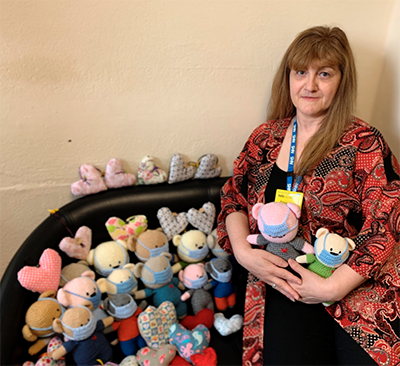
The sudden rise in COVID-19 patients being transferred from other hospitals for specialist treatment prompted a flood of phone calls from relatives, desperate for news about their loved ones.
Calls were initially routed through to critical care wards, putting huge pressure on frontline staff, and it became clear early on that additional support was needed.
Experts from the rehabilitation and therapies teams quickly organised a family liaison service to provide the support needed.
Lauren Berry, associate director patient services, explained: “We had to close our hospitals to visiting to protect our patients and staff from increased risk of infection, which put considerable pressure on relatives at an already stressful time.
“Not being able to see a very sick relative or have a good understanding of the illness and the current care in place is very difficult. This was resulting in a high volume of calls, which was adding to the pressure on our staff.”
The service was co-ordinated by the supportive and palliative care team together with their lead nurse, Mary Williams, and outpatient sister Claire Denney.
A call for volunteers resulted in 39 staff members supporting the service – all were contributing support within their current roles, and on days off and weekends. They included a range of nurses, allied health professionals such as physiotherapists and speech and language therapists, and chaplains.
Members of the service worked on a seven-day rota contacting families as soon as possible after their relatives came into one of our hospitals. Each family was sent a letter explaining there would be a daily call from the service to provide an update about the last 24 hours, together with general information about the intensive care their relatives were receiving.
Rosa Osbourne, the palliative care co-ordinator, monitored messages and photographs sent by families to a dedicated email address. These were then printed, laminated and taken to bedsides. To help people feel more connected, a matching pair of knitted hearts was offered with one put beside each patient and the other sent to the family. Knitted teddies were sent to children.
Service volunteers were also able to refer families who needed additional help to the Trust’s welfare advisor, psychology or chaplaincy teams.
Lauren said: “The number of calls to wards quickly dropped taking pressure off frontline doctors and nurses.” Volunteer Cathy Bindoff, governance and safety lead in rehabilitation and therapies, said: “Working as part of the service was a very rewarding and positive experience all round. As a remote worker I felt I was really able to help support my colleagues and to give family members much more time to talk and process what was happening to their loved-ones.
“On many occasions, my phone calls to families were answered with statements such as ‘I have been looking forward to your call’. I was also asked if I could just explain things such as what ‘inflammatory markers’ were because relatives didn’t want to ask the doctors as they knew they were so busy. There were some difficult and challenging conversations with families, but the staff working in the service were wonderful at supporting each other and we had regular online meetings to share and discuss feedback from calls.”
< Contents
